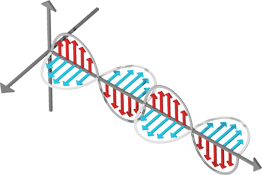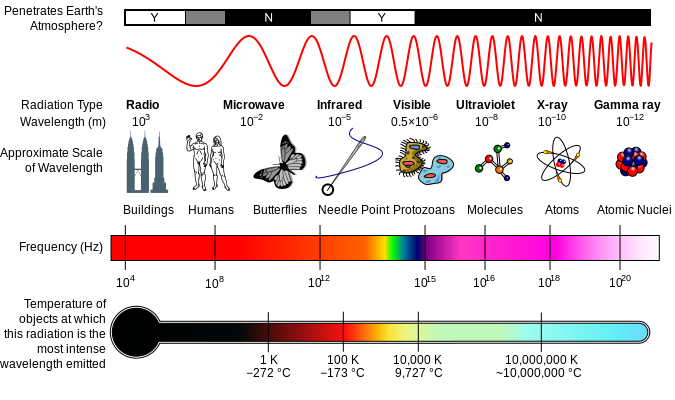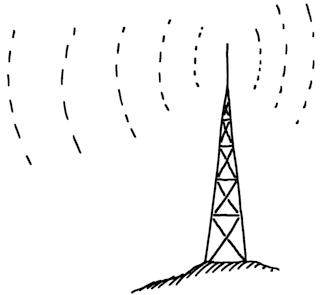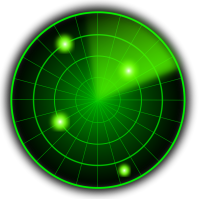
Electromagnetic Waves
Every day we meet with them. We feel them, we are using them, and we won’t be able to see without them. So what are they? What are EM waves?


EM Wave
Magnetic field
Electric field
E
 lectromagnetic
radiation
is a form of energy emitted and absorbed by charged particles, which
exhibits wave-like behavior as it travels through space.
Electromagnetic
waves
are a
stream of energy-bearing particles that travels outward from an
electromagnetic source. EMR has both electric and magnetic field
components. In a vacuum, all electromagnetic waves travels at the
speed called “speed of light” (300 000
km/sec).
Electromagnetic wave transfer
energy
(also called radiant
energy)
continuously away from the source.
lectromagnetic
radiation
is a form of energy emitted and absorbed by charged particles, which
exhibits wave-like behavior as it travels through space.
Electromagnetic
waves
are a
stream of energy-bearing particles that travels outward from an
electromagnetic source. EMR has both electric and magnetic field
components. In a vacuum, all electromagnetic waves travels at the
speed called “speed of light” (300 000
km/sec).
Electromagnetic wave transfer
energy
(also called radiant
energy)
continuously away from the source.
Electromagnetic spectrum
In general, EM radiation is divided in several categories by wavelength:
Radio waves
Microwaves
Infrared waves
Visible spectrum of EM waves (light)
Ultraviolet waves
X-Rays
Gamma Rays

Let’s talk about each of them more detailed.
R adio
Waves
adio
Waves
Radio waves were first predicted by mathematical work done in 1867 by James Clerk Maxwell and then, in 1887, Heinrich Hertz demonstrated the reality of Maxwell's predictions.
Radio waves have frequencies from 300 GHz to 3 kHz, and wavelengths from 1 millimeter to 100 kilometers. Radio waves are made by various types of transmitter, depending on their wavelength. They can also occur naturally: they are given off by stars, sparks and lightning.
Radio waves are divided into:
Long Wave, around 1~2 km in wavelength.
Medium Wave, around 100m in wavelength, used by "AM" stations.
Vhf (Very High Frequency) has wavelengths of around 2m. This is where you find stereo "fm" radio stations.
UHF (Ultra High Frequency), has wavelengths of less than a meter. It is used for Police radio communications, television transmissions and military aircraft radios - although military communications are now mostly digital and encrypted.

 Radio
waves are very frequently used in many spheres, such as:
Radio
waves are very frequently used in many spheres, such as:
Radio communication
Broadcasting

Radar and other navigation systems

Communications satellites
Computer networks
Medicine
Radio waves are very important in our life. They play an important role in communication and data transmission. Without them we wouldn’t have radio, television, and many other useful things.
Dangers:
Large doses of radio waves are believed to cause cancer, leukemia and other disorders.
 Microwaves
Microwaves
Microwaves are basically extremely high frequency radio waves, and are also made by various types of transmitter. In mobile phone, for example, they are made by transmitter chip on antenna, in a microwave oven they are made by a "magnetron". Microwaves have wavelength from 1 mm to 1 meter and frequencies between 300 GHz and 300 MHz.
A
microwave telecommunications tower.

C
 ommunication
ommunication
Radar
Radio astronomy

Navigation

Power
Spectroscopy
One of the most common uses of microwaves is microwave ovens, because microwaves cause water and fat molecules to vibrate, which makes the substances hot. The most important use of microwaves nowadays is mobile phones. We wouldn't be able to communicate through long distances without using wires if we didn't discover microwaves.
Dangers
Long exposure of microwaves is known to cause "cataracts" in your eyes, which is a clouding of the lens, preventing you from seeing clearly or seeing at all. So don't make a habit of pressing your face against the microwave oven door to see if your food's ready!
Recent research shows that microwaves from mobile phones can affect parts of your brain - after all, you're holding the transmitter right by your head. So do not to spend too long on the phone!
